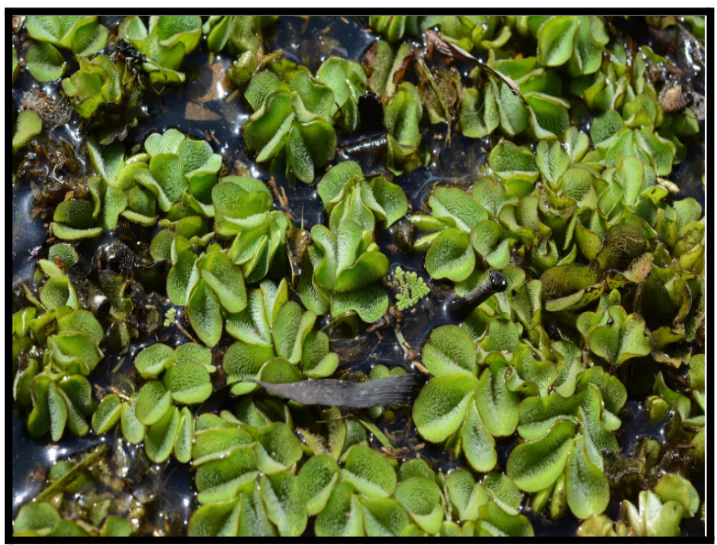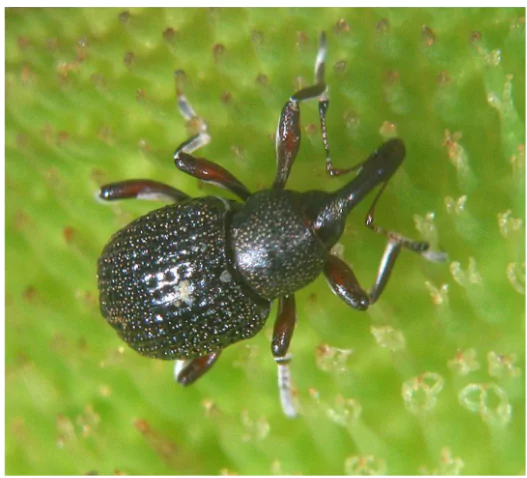The introduction of the Brazilian insect ‘Cyrtobagous salviniae’ provided an effective and cost-efficient solution to the invasive aquatic weed ‘Salvinia molesta’ in Madhya Pradesh.
Background
- Infestation by Salvinia molesta: A Village in Betul district, Madhya Pradesh, faced severe livelihood challenges due to the infestation of the aquatic weed Salvinia molesta, locally known as “Chinese Jhalar.”
- Timeline of Infestation
- The infestation of Salvinia molesta began in 2018.
- By 2022, the reservoir was overwhelmed, leading to significant issues.
Enroll now for UPSC Online Course
Salvinia molesta

- About: It is a dense invasive free-floating plant that does not attach to the soil, but instead remains buoyant on the surface of a body of water.
- It has become a significant problem in various regions due to its rapid growth and ability to form dense mats on water surfaces.
- Origin and Spread
- Salvinia molesta is originally from Brazil and Argentina.
- It has spread worldwide through the aquarium and horticulture industries, reaching Australia, Africa, Madagascar, India, Sri Lanka, Southeast Asia, the Philippines, Indonesia, Papua New Guinea, Fiji, and New Zealand.
- Weeds are plants that are considered undesirable, invasive, or harmful in areas, such as gardens, agricultural fields, or natural habitats.
- They compete with cultivated plants for resources like water, nutrients, and sunlight.
- Examples of some common weeds are: Carrot grass, Nut grass, Silverleaf nightshade, etc.
|
- Introduction to India
- In India, the weed was first observed in Veli Lake, Thiruvananthapuram, in 1955.
- By 1964, it was classified as a ‘pest’ in India.
- Ecological Impact
- Salvinia molesta has a significant ability to choke rivers, canals, lagoons, and other water sources, causing severe ecological disruptions.
- It outgrows and replaces native aquatic plants, affecting food sources and habitats for animals and waterfowl.
- IUCN List: The IUCN (International Union for Conservation of Nature) has added Giant Salvinia to its list of the world’s worst invasive alien species.Impact of the Invasion of Salvinia Molesta
- Ecological and Economic Damage
- The weed’s dense coverage made water extraction impossible.
- Fish populations died, and lotus plants rotted due to the infestation.
- Impact on Local Livelihoods
- The severe weed growth disrupted local fishermen’s livelihoods.
- Many fishermen were forced to migrate for work due to the economic hardship caused by the infestation.
Check Out UPSC CSE Books From PW Store
Introduction of Cyrtobagous Salviniae as a Solution
- About Cyrtobagous salviniae: It is used as an agent of biological pest control against the noxious aquatic plant giant salvinia (Salvinia molesta).
 ‘Cyrtobagous salviniae’ was introduced to India from Australia in 1982, with successful trials in Bangalore and Kerala before reaching Central India.
‘Cyrtobagous salviniae’ was introduced to India from Australia in 1982, with successful trials in Bangalore and Kerala before reaching Central India.
- Proposed Solution
- A team from Jabalpur proposed using the Brazilian insect ‘Cyrtobagous salviniae’, which targets and feeds on Salvinia molesta to control its spread.
- These insects are bred at the Weed Research Directorate in Jabalpur, where research is also conducted to study their effects.
- Implementation
- The insect was introduced to the affected ponds in September 2022.
- Regular releases of the insect continued until March 2023.
- Results
- The program achieved significant success, with the weed completely decomposing within 18 months, ahead of the expected time frame.
- The effectiveness of the program led to crystal-clear water in previously affected lakes.
- Sustaining Cyrtobagous salviniae with Host Plants
-
- As the presence of Salvinia molesta diminishes, additional green weed is introduced to sustain the insect population.
- These insects rely on the weed as their host, and if the weed is not present, the insects cannot survive.
- The green weed is cultivated in tankers, where it is grown and later introduced into the pond
Advantages of the Organic Solution
- Cost Effective: The use of ‘Cyrtobagous salviniae’ was significantly more cost-effective compared to manual removal methods, which were estimated to cost 15-20 crores and take 5-6 years.
- Minimised risks: The organic method not only solved the problem efficiently but also minimised risks associated with manual removal of weeds.
Enroll now for UPSC Online Classes
Invasive Alien Species (IAS)
- About: It defines Invasive Alien Species (IAS) as “species whose introduction and/or spread outside their natural past or present distribution threatens biological diversity”.
- The Cartagena Protocol on Biosafety to the Convention on Biological Diversity (CBD) recognizes an urgent need to address the impact of invasive species.
- Includes: These include animals, plants, fungi, and even microorganisms, and can influence all kinds of ecosystems.
- Examples: Prosopis Juliflora, Lantana Camara, Water hyacinth, Mimosa, Siam etc.
- Reasons for the Spread of Invasive Alien Species (IAS)
- Globalisation: Increased trade, transport, and tourism facilitate the introduction and spread of IAS.
- Cargo ships, aeroplanes, and vehicles can unintentionally spread invasive species by transporting them in cargo, through ballast water, or attached to their surfaces.
- Climate Change: Warming temperatures support the expansion of IAS, such as the Asian longhorned beetle surviving in colder regions.
- Habitat Degradation: Urbanisation, deforestation, and unsustainable land use disrupt native ecosystems, aiding IAS establishment.
- Anthropogenic Reasons: IAS introduced for economic purposes, like agriculture or ornamental use, can become invasive, e.g., Lantana camara.
- Inadequate Biosecurity Measures: Insufficient inspection and regulation of imported goods and IAS movement contribute to their spread.
- Lack of Awareness: Public ignorance and inadequate funding and resources hinder effective management and eradication of IAS.
- Global Regulatory Framework for Management of Invasive Alien Species:
- United Nations Convention on Biological Diversity, 1992: It emphasises the need to prevent the introduction of, control, or eradicate invasive alien species that threaten ecosystems, habitats, or species.
- Kunming-Montreal Global Biodiversity Framework, 2022: It has been agreed under the United Nations Convention on Biological Diversity (UN CBD) and aims to reduce the rate of introduction and establishment of invasive alien species by at least 50% by 2030.
- Convention on the Conservation of Migratory Species, 1979: It aims to conserve migratory species and includes measures to control or eliminate invasive alien species already present.
- Convention on International Trade in Endangered Species of Wild Fauna and Flora (CITES), 1975: It focuses on ensuring international trade that does not threaten the survival of wild animals and plants and considers the impact of invasive species involved in trade.
- Global Invasive Species Programme: It supports research, capacity building, and management strategies to address invasive species issues worldwide.
|
![]() 14 Aug 2024
14 Aug 2024

 ‘Cyrtobagous salviniae’ was introduced to India from Australia in 1982, with successful trials in Bangalore and Kerala before reaching Central India.
‘Cyrtobagous salviniae’ was introduced to India from Australia in 1982, with successful trials in Bangalore and Kerala before reaching Central India.